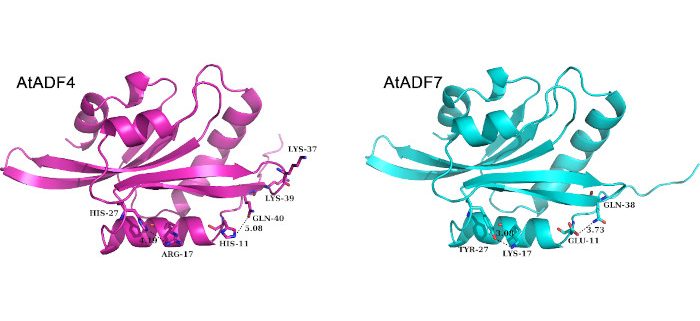Pollen beats the heat with thermostable actin-depolymerizing factors
Qian et al. investigate how the evolution of the thermostability of actin-depolymerizing factors enhances the adaptation of pollen germination to high temperature. The Plant Cell (2023).
https://doi.org/10.1093/plcell/koad280
By Qian D., Li T., Chen S., Wan D., He Y., Zheng C., Li J., Sun Z., Li J., Sun J., Niu Y., Li H., Wang M., Niu Y., Yang Y., An L., and Xiang Y.
Background: Double fertilization of most angiosperms occurs in the heat of summer; understanding how the male gametophytes (pollen grains) germinate properly and pollen tubes grow normally at high temperature is essential to elucidating the evolution of angiosperm reproduction. Pollen tubes transport immobile sperm cells to ovules to complete double fertilization, thereby starting seed development. Rapid pollen tube growth requires dynamic remodeling of the actin cytoskeleton, which is finely regulated by numerous actin binding proteins (ABPs). Therefore, understanding of ABP-mediated actin regulation of pollen germination and pollen tube growth at high temperature will help shed light on the evolution of angiosperms.
Question: How does the actin cytoskeleton respond to high temperatures and what is the mechanism by which it regulates pollen germination and pollen tube growth at high temperature?
Findings: Angiosperm actin-depolymerizing factors (ADFs), a family of ABPs, have been identified as limiting factors in rapid actin turnover Here, we revealed that the evolution of the high thermal stability of ADFs played a pivotal role in the origin and evolution of adaptation to high temperature in Arabidopsis (Arabidopsis thaliana). Specifically, (i) 11 AtADFs show substantially different thermal stabilities, with ADFs that are expressed specifically in polar cells (pollen and root hairs) showing high thermal stability. (ii) The Sub II ADFs AtADF7 and AtADF10, which are expressed specifically in pollen, originated from the ancestral protein ancADF-A with high thermal stability, but their thermostable sites differ from those of ancADF-A, which underwent a wave-like evolution of the loss of ancestral thermostable sites and regeneration of new sites. (iii) The high thermal stability and thermostable sites of AtADF7 are conserved in ADFs specific to angiosperms. (iv) The high thermal stability of ADFs is necessary for regulating actin turnover to promote pollen germination at high temperature.
Next steps: A series of ABPs act together to regulate the dynamics of the intracellular actin cytoskeleton; as next steps, we will explore and determine which other ABPs with high thermal stability are involved in regulating pollen germination and pollen tube growth at high temperatures.
Reference:
Qian, Li, Chen et al. (2023). Evolution of the thermostability of actin-depolymerizing factors enhances the adaptation of pollen germination to high temperature. https://doi.org/10.1093/plcell/koad280




